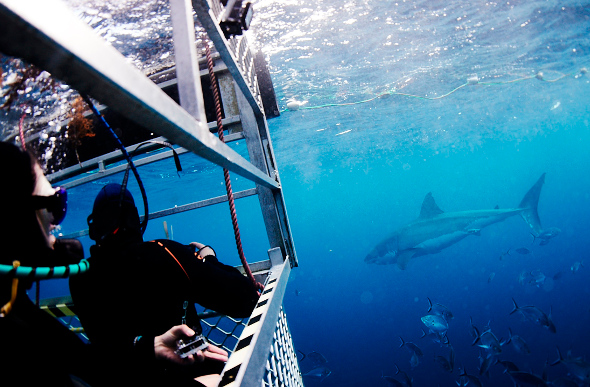
"It's a kill, it's a kill," shouts our skipper. A dark, red shiny film drifts on the water's surface with the tide, dispersing slowly. This is all that's left of the seal. It has been attacked and eaten by one of the world' s most deadly hunters, the great white shark.
I am on a converted fishing boat, moored off a small set of islands (Neptune) three hours out of Port Lincoln in South Australia, about six hours' drive from Adelaide.
There are 20 other adventure-seekers waiting to jump into the shark cage. We are here to see these killers in their natural habitat, in the cold, green waters of the Great Southern Ocean.
 Great whites are even more fearsome up close (Image: Getty)
Great whites are even more fearsome up close (Image: Getty)
Kitted up in a thick wet suit with hood, I place and adjust the mouthpiece, before swinging my legs into the open-top cage. Climbing the few steps inside I can feel the cold rush of water down my back. It's a little spooky at first, but I soon adjust to my surroundings.
Adrenalin pumping, I turn around and see the ocean floor below me. Visibility is about 15 metres. Then slowly it appears: a large shadow moving gracefully past the cage.
The shadow has teeth, lots of them. Then the rest of it materialises into a four-metre killing machine. But that’s why I'm here, standing in freezing cold water behind steel bars staring into the depths. I'm not the least bit afraid, merely fascinated.
The great white's graceful movements accentuate its perfectly formed streamlined shape. This is it's home and I am in its hunting ground.
 Keep your eye on the predator (Image: Adventure Bay Charters)
Keep your eye on the predator (Image: Adventure Bay Charters)
More South Australia holiday inspiration
Longing For South Australia's Beaches
South Australia: An Authentic Aussie Experience
Matt, our skipper, has years of experience and his love of sharks has given him the opportunity to share these lifelong moments with others. He is accompanied by a marine biologist who answers all my questions about the sharks and their habits, excluding one.
Great white sharks can travel thousands of kilometres on their quest. But why? No one really knows. Only more research can answer questions about one of the oldest predators of the ocean.
There are two other boats in the bay, a dive boat run by Rodney Fox, another great white expert. This is for the qualified scuba divers.
The other boat offers the Jaws experience by hurling fish heads on a rope into the water and teasing the sharks. It reminds me of throwing a stick to a large dog. Only this dog has scarily large teeth and weighs half a tonne.
 Come face to face with one of the world's most powerful killing machines (Image: Adventure Bay Charters)
Come face to face with one of the world's most powerful killing machines (Image: Adventure Bay Charters)
As the day progresses, the water visibility decreases and the sharks tend to swim at the bottom of the ocean floor. Here, they are camouflaged from above by their dark-grey colouring. The seals swimming on the surface cannot see them.
I have ample opportunities to stand in the shark cage. Each time I see at least two sharks always cruising past in their slow, deliberate manner. I consider scuba diving with them would be a fascinating experience.
Finally, I become too cold and decide to call it a day. As I am changing on deck, I hear a shout from Matt: "Look at that!"
A shark has launched itself out of the water; the head and pectoral fins quite visible. It has mauled one of the 35-litre plastic containers tied to the back of the boat, which happens to be our loud speaker currently playing Born to be Wild by Steppenwolf.
"I guess it doesn't like the music," says Matt.
Words: Mike Barrow











